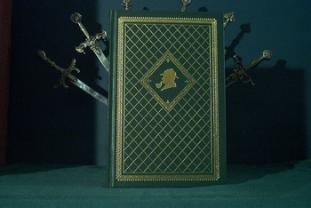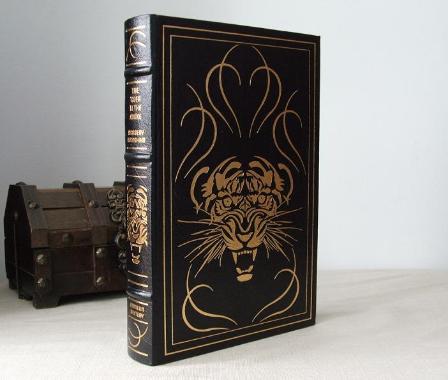Mousetrap and other plays by Agatha Christie - 1987
Rebecca by Daphne Du Maurier - 1987
The Great cases of Sherlock Holmes by Arthur Conan Doyle - 1987
The day of the Jackal by Frederick Forsyth - 1987
Ashenden (or British agent) by W. S. Maugham - 1987
The Maltese Falcon by Dashiell Hammett - 1987
Tales of mystery and imagination by Edgar Allan Poe - 1987 (black cover - gold bug)
Tales of mystery and imagination by Edgar Allan Poe - 1987 (red cover )
The Patience of Maigret by Georges Simenon - 1987
Trent's Last Case by E. C. Bently - 1988
The 39 Steps by John Buchan - 1988
Postman always rings twice by James M. Cain - 1988
Farewell My Lovely by Raymond Chandler - 1988
The Moonstone by Wilkie Collins - 1988
The Ipcress File by Len Deighton - 1988
Blood Sport by Dick Francis - 1988
The Mystery of Edwin Drood by Charles Dickens - 1988
The Man from the Sea by Michael Innes - 1988
Tinker Tailor Soldier Spy by John Le Carré - 1988
Fer-De-Lance by Rex Stout - 1988
Anatomy of Murder by Robert Traver - 1988
Picture of Dorian Gray by Oscar Wilde - 1988
Great American Mysteries by various authors - 1989
The House without a Key by Earl Derr Biggers - 1989
Laura by Vera Caspary - 1989
The Innocence of Father Brown by G. K. Chesterton - 1989
The Long Divorce by Edmund Crispin - 1989
D.A. calls it Murder by Erle Stanley Gardner - 1989
Ghostly Tales by Henry James - 1989
A Kiss before Dying by Ira Levin - 1989
Thank you Mr. Moto and Mr. Moto is so sorry by John P. Marquand - 1989
The Roman Hat Mystery by Ellery Queen - 1989
Murder Must Advertise by Dorothy Sayers - 1989
Strange case of Dr. Jekyll & Mr. Hyde by Robert Louis Stevenson - 1989
The Bride wore Black by Cornell Woolrich - 1989
Great British Mysteries of the 20th century by various authors - 1990
The Tiger in the Smoke by Margery Allingham - 1990
A coffin for Dimitrios by Eric Ambler - 1990
The Beast Must Die by Nicolas Blake - 1990
The Benson Murder Case by S. S. Van Dine - 1990
Payment Deferred by C. S. Forester - 1990
Quiet as a Nun by Antonia Fraser - 1990
Raffles by E. W. Hornung - 1990
Compulsion by Meyer Levin - 1990
The Lodger by Marie Belloc Lowndes -1990
Overture to Death by Ngaio Marsh - 1990
The Red House Mystery by A. A. Milne - 1990
The Man in the corner by Baroness Orczy - 1990
The Door by Mary Rinehart - 1990
The Insidious Dr. Fu Manchu by Sax Rohmer - 1990
The Daughter of Time by Josephine Tey - 1990
The Crimson Circle by Edgar Wallace - 1990
(This page contains affiliate links for which we may be compensated.)
Mystery fiction is a loosely-defined term that is often used as a synonym for detective fiction or crime fiction— in other words a novel or short story in which a detective (either professional or amateur) investigates and solves a crime. Sometimes mystery books are nonfiction. The term "mystery fiction" may sometimes be limited to the subset of detective stories in which the emphasis is on the puzzle element and its logical solution (cf. whodunit), as a contrast to hardboiled detective stories, which focus on action and gritty realism. However, in more general usage "mystery" may be used to describe any form of crime scene fiction, even if there is no mystery to be solved.
Although normally associated with the crime genre, the term "mystery fiction" may in certain situations refer to a completely different genre, where the focus is on supernatural mystery (even if no crime is involved). This usage was common in the pulp magazines of the 1930s and 1940s, where titles such as Dime Mystery, Thrilling Mystery and Spicy Mystery offered what at the time were described as "weird menace" stories – supernatural horror in the vein of Grand Guignol. This contrasted with parallel titles of the same names which contained conventional hardboiled crime fiction. The first use of "mystery" in this sense was by Dime Mystery, which started out as an ordinary crime fiction magazine but switched to "weird menace" during the latter part of 1933.
Classifications
Mystery fiction can be divided into several categories, among them the "cozy mystery", "police procedural", and "hardboiled" (for instance, Dashiell Hammett's The Maltese Falcon's main detective, Sam Spade).
History
The earliest known murder mystery and suspense thriller with multiple plot twists and detective fiction elements was "The Three Apples", or in Arabic, Hikayat al-sabiyya 'l-muqtula ("The Tale of the Murdered Young Woman"), one of the tales narrated by Scheherazade in the One Thousand and One Nights (Arabian Nights). In this tale, a fisherman discovers a heavy locked chest that is painted pink with flowers on it along the Tigris river and he sells it to the Abbasid Caliph, Harun al-Rashid, who then has the chest broken open only to find inside it the dead body of a young woman who was cut into pieces. Harun orders his vizier, Ja'far ibn Yahya, to solve the crime and find the murderer. This whodunit mystery may be considered an archetype for detective fiction.
An early work of modern mystery fiction, Das Fräulein von Scuderi by E.T.A. Hoffmann (1819), was an influence on The Murders in the Rue Morgue by Edgar Allan Poe (1841). Wilkie Collins' epistolary novel The Woman in White was published in 1860, while The Moonstone (1868), is often thought to be his masterpiece. In 1887 Arthur Conan Doyle introduced Sherlock Holmes, whose mysteries are said to have been singularly responsible for the huge popularity in this genre. The genre began to expand near the turn of century with the development of dime novels and pulp magazines. Books were especially helpful to the genre with many authors writing in the genre in the 1920s. An important contribution to mystery fiction in the 1920s was the development of the juvenile mystery by Edward Stratemeyer. Stratemeyer originally developed and wrote the Hardy Boys and Nancy Drew mysteries written under the Franklin W. Dixon and Carolyn Keene pseudonyms respectively (and were later written by his daughter, Harriet Adams, and other authors). The 1920s also gave rise to one of the most popular mystery authors of all time, Agatha Christie, whose works include Murder on the Orient Express (1934), Death on the Nile (1937), and the world's best-selling mystery And Then There Were None (1939).
The massive popularity of pulp magazines in the 1930s and 1940s increased interest in mystery fiction. Pulp magazines decreased in popularity in the 1950s with the rise of television so much that the numerous titles available then are reduced to two today: Alfred Hitchcock's Mystery Magazine and Ellery Queen's Mystery Magazine. The detective fiction author Ellery Queen (pseudonym of Frederic Dannay and Manfred B. Lee) is also credited with continuing interest in mystery fiction.
Interest in mystery fiction continues to this day because of various television shows which have used mystery themes and the many juvenile and adult novels which continue to be published. There is some overlap with "thriller" or "suspense" novels and like authors in those genres may consider themselves mystery novelists. Comic books and like graphic novels have carried on the tradition, and film adaptations have helped to re-popularize the genre in recent times.
Additional information and source: Mystery fiction


